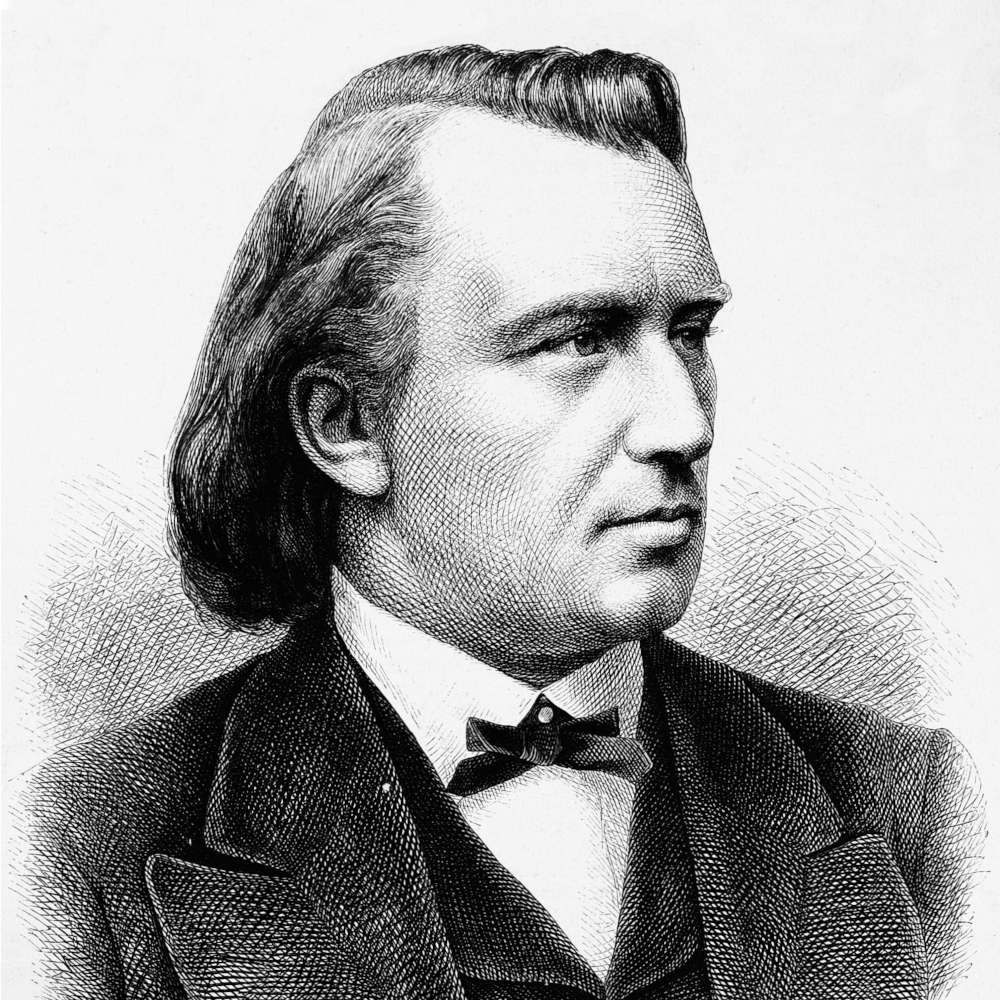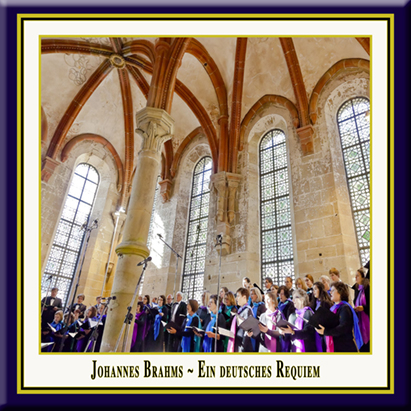Johannes Brahms · A German Requiem
A German Requiem
Ein deutsches Requiem, Op. 45
The "London Version" (sung in German)
for 2 soloists, choir and four-hand piano,
arranged by the composer, performed by
Heidi Elisabeth Meier (Soprano), Josef Wagner (Baritone),
Piano Duo GrauSchumacher (Andreas Grau & Götz Schumacher),
Maulbronn Chamber Choir (Maulbronner Kammerchor)
Conductor: Jürgen Budday
A live recording from the German
UNESCO World Heritage Site Maulbronn Monastery
HD Recording · DDD · Duration: c. 70 Minutes



O
n Good Friday, April the 10th, 1868, the world premiere of the Requiem in a six movements version was given in Bremen, Germany. Brahms himself conducted the Choral Society of Bremen, having carefully been prepared by Karl Martin Reinthaler to perfom the new release. Friends of Brahms from all over Germany were attending this occasion. Clara Schumann noted in her diary: '... This requiem deeply moved me like no other sacred music... As I saw Johannes standing there with the baton in his hand, I always had to think of my dear Robert's prophecy - let him just take the magic wand, and let him operate with an orchestra and a choir - that is fulfilling today. The baton really transformed into a magic wand and vanquished Everybody, even his most determined enemies. This was such blissfulness for me, I haven't felt so delighted in years. After the performance was a supper at the Rathskeller, where everybody jubliated - it was a celebration of music.'
After the performance in Bremen, Brahms returned to Hamburg, where he finished the work by the addition of the movement. 'You now have sadness' that was finished in the autograph of the particell with 'Hamburg May 68'. In 1869 eventually, the complete opus was performed at the 18th of February in Leipzig under the direction of Karl Reinecke. Eduard Bernsdorf, the critic of the journal 'Signals of the musical world', who ten years earlier had called the piano concerto in d-minor a piece of 'bleakly waste and drought', nowhad no choice but to acknowledge in his critique on February the 22th, 1869: '... you so have to number the questionable work of Brahms among the most important doings having been accomplished by our younger and youngest generation of composers, as well as you have to designate it the most important of the Brahmsian creations. Above all, an aspiration for the Grand and Noble does announce itself here and, coherring, the complete negation of the Ordinary and Banal...'
Johannes Brahms himself produced a four-handed version of his German Requiem for piano that was publicized first in London in 1871. The publication of simplified musical versions for piano duo was common in the 19th century, being in some respects the precursor of acoustical recording because it allowed musical amateurs to experience great works outside the concert hall by their own performance on the piano. Brahms worked on this version himself, i.a. out of the conviction that if it really had to happen, he would be the best candidate for this duty.
All in all, he considered this work as unworthy, but necessary, thus he refused noting his name as arranger on the front page, and as it happened anyhow, he ordered the exemples already printed to be recollected and added with new front pages not naming him as arranger any longer. In a letter Brahms stated ironically: 'I dedicated myself to the noble occupation of rendering my immortal creation enjoyable also for the four-handed soul. Now it can't decline.'.
Even if it obviously didn't answered the Maestro's basic idea, the piano version gives considerably more room for dynamics and therefore serves the tension of the work. Prior condition is a choir and a conductor that see an opportunity and even are challengend by the minimalism of the instrumentation in filling these deep moments with all the tension human voice is capable of. The vocal performance is enriched by the convertion of the piano version by Brahms himself, because he in person decided on the atmospheric form of his presentation. It is quite exciting to hear the chamber choir merge into word and work and having the courage of dedicating itself to the Requiem's spirit.
P
ublishing Authentic Classical Concerts entails for us capturing and recording outstanding performances and concerts for posterity. The performers, audience, opus and room enter into an intimate dialogue that in its form and expression, its atmosphere, is unique and unrepeatable. It is our aim, the philosophy of our house, to enable the listener to acutely experience every facet of this symbiosis, the intensity of the performance, so we record the concerts in direct 2-Track Stereo digital HD. The results are unparalleled interpretations of musical and literary works, simply - audiophile snapshots of permanent value. Flourishing culture, enthralling the audience and last but not least also you the listener, are the values we endeavor to document in our editions and series.
The concerts at the UNESCO World Heritage Maulbronn Monastery supply the ideal conditions for our aspirations. It is, above all, the atmosphere of the romantic, candle-lit arches, the magic of the monastery in its unadulterated sublime presence and tranquillity that impresses itself upon the performers and audience of these concerts. Renowned soloists and ensembles from the international arena repeatedly welcome the opportunity to appear here - enjoying the unparalleled acoustic and architectural beauty of this World Heritage Site, providing exquisite performances of secular and sacred music, documented by us in our Maulbronn Monastery Edition.
Andreas Otto Grimminger & Josef-Stefan Kindler, K&K Verlagsanstalt

A reference recording
Interpretation: ***** (5 out of 5)
Recording Quality: ***** (5 out of 5)
Status: Reference Recording

Magnificently performed and recorded...
Fine Reduction and Fine Performance
Brahms' own piano reduction of his Requiem. It works wonderfully in this format and this recording is magnificently performed and recorded. This will not replace the orchestra version (and certainly was not meant to) but it allows one to hear the work in a new way...

***** Certainly Five Stars!
Item getting today, 04/13/17. A very interesting interpretation of the famous Brahms German Requiem for piano duo, choir and soloists; the London version, in contrary to the later full orchestral, choir and soloists version. This chamber version makes this work more a delightful and receptable one during this Passion Time.





***** Certainly Five Stars!
17. April 2017 - 11:05 — kuk-art.comJ. P. M. Smit on Amazon.com, April 13, 2017
Magnificently performed and recorded...
18. March 2017 - 14:05 — kuk-art.comBrahms' own piano reduction of his Requiem. It works wonderfully in this format and this recording is magnificently performed and recorded. This will not replace the orchestra version (and certainly was not meant to) but it allows one to hear the work in a new way...
'Bachjscpe' on Amazon.com
A reference recording
23. December 2014 - 13:31 — kuk-art.comMaulbronner Kammerchor. Heidi Elisabeth Meier, Sopran. Josef Wagner, Bariton.
Andreas Grau und Götz Schumacher, Klavier.
Künstlerische Leitung: Jürgen Budday.
Edition Kloster Maulbronn. K&K Verlagsanstalt 2012. KuK 105.
Interpretation: ***** (5 von 5)
Fertigung/Aufnahmequalität: ***** (5 von 5)
Künstlerischer Stellenwert: Referenz-Aufnahme
"Ein Deutsches Requiem" - schon dieser Titel verweist auf ein ganz besonderes Werk der Musikgeschichte. Bis hin zu dieser Schöpfung von Brahms verstand man unter "Requiem" oder "Totenmesse" fast ausschließlich eine liturgisch konzipierte Kirchenmusik. Das Requiem von Brahm ist zwar ein religiöses, aber kein liturgisches Werk, das sich als kantatenhafte Chorkomposition auch stilistisch von den bis dahin entstandenen Werken abhebt. Brahms stand dem sich allgemein gewandelten religiösen Empfinden der zweiten hälfte des 19. Eahrhunderts nahe; in dem hohen Niveau der texte spiegelt sich diese Einstellung von Brahms wider: er stellte sie persönlich aus der Luther-Bibel zusammen, wich damit einer Dogmatisierung weitgehend aus. Ebenso neu ist bei Brahms die umfassende liedmäßige Ausgestaltung, die sich keinesfalls an den traditionellen lateinischen Totenmessen orientiert. Seit damals gibt es religiös-geistliche Musik im Konzertsaal, wie auch geistliche, aber nicht-liturgische Kompositionen für die Kirche, was u. a. zur Folge hatte, dass die Kirchenräume allmählich auch als Konzertpodien genutzt wurden. Johannes Brahms hatte nach der Uraufführung seines "Deutschen Requiems" 1868 in Bremen mit diesem Werk - worin er "zu meisterlichen Reife gedieh" (MGG) - einen überwältigenden Erfolg. Dass Brahms gänzlich unkonventionell bei der Komposition vorging, zeigt sich auch an der Besetzung. Anstelle der meist vier oder fünf Solisten will Brahms "nur" Sopran und Bariton. Und nach der Uraufführung schuf er persönlich noch eine reduzierte Besetzung für zwei solisten, Chor und Klavier zu vier Händen, die 1871 in London zum ersten Mal aufgeführt wurde. In dieser verkleinerten Besetzung, die ganz wesentlich zur Verbreitung des Werkes beitrug, erklingt "Ein Deutsches Requiem" von Johannes Brahms seither in zahlreichen Aufführungen und ist somit eines seiner beliebtesten Chorwerke.
Der Maulbronner Kammerchor - als künstlerische Formation seit 1983 bestehend - unter der Leitung von Jürgen Budday präsentiert eine traumhafte Aufnahme dieses schon häufig eingespielten Meisterwerkes. Wir hören eine ausdrucksvolle Artikulation, eine saubere Intonation mit starken dynamischen Steigerungen, die vom Konzertflügel homogen gestützt werden. Die fugierten Choreinsätze mit einem brillanten Sopran kommen absolut sicher an. Bei der Phrasierung der musikalischen Strukturen fasziniert die deutliche Zeichnung und Artikulation, selbst bei der Steigerung in Motorik und Dynamik, etwa im 6. Satz, steht die musikalische Aussage im Vordergrund. Die Sopranistin Heidi E. Meier besticht mit ihrer herausragenden, mozartisch-geprägten Stimme. Und der Bariton Josef Wagner demonstriert mit seiner vollen Stimme klare Höhen. Schließlich ist der Klavierpart mit Andreas Grau und Götz Schumacher nicht dominierend, sondern erklingt stets als homogener, musikalisch gleichwertiger Anteil. Das Klangbild ist also insgesamt sehr abgerundet und nobel. Bei dieser Aufnahme wirkt ein Spitzenchor mit, und dem Schöpfer Johannes Brahms hätte diese Darstellung seiner Musik mit Sicherheit zugesagt.
Wer das "Deutsche Requiem" noch nicht kennen sollte, müsste sich diese Aufnahme unbedingt als Schlüsselhörerlebnis zulegen. (juli)
KULIMU - Zeitschrift für Kunst & Literatur & Musik (Ausgabe 3/2012)